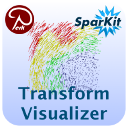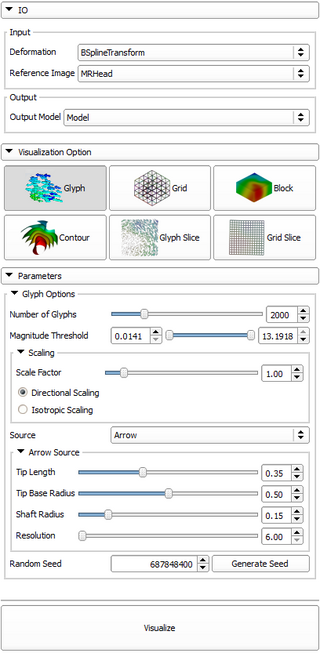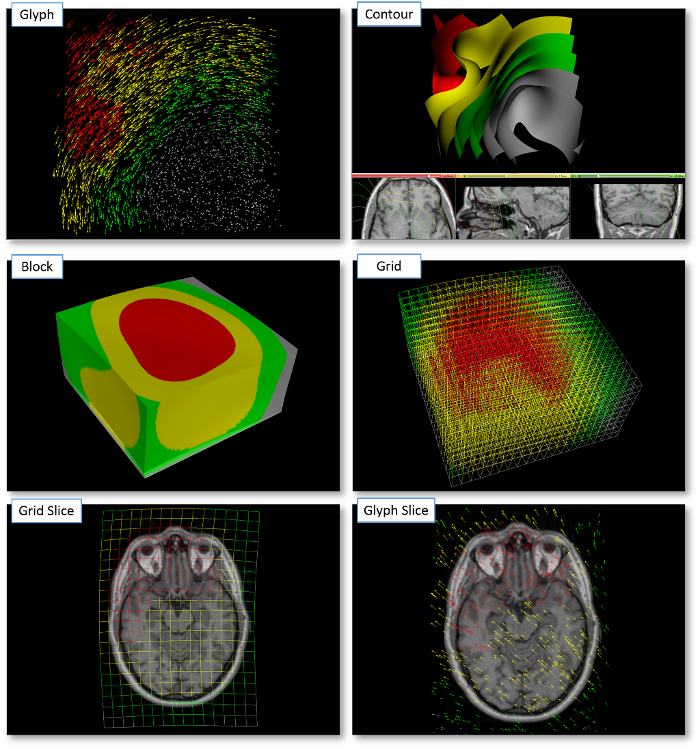Documentation/Nightly/Modules/TransformVisualizer
|
For the latest Slicer documentation, visit the read-the-docs. |
Introduction and Acknowledgements
|
This work is part of the SparKit project, funded by An Applied Cancer Research Unit of Cancer Care Ontario with funds provided by the Ministry of Health and Long-Term Care and the Ontario Consortium for Adaptive Interventions in Radiation Oncology (OCAIRO) to provide free, open-source toolset for radiotherapy and related image-guided interventions. | |||||||
|
Module Description
|
The Transform Visualizer module visualizes transforms using various options. The module can visualize any transform (linear transform, B-spline deformable transform, any other non-linear transform) or vector volume. |
Use Cases
- Visualize deformation fields
- Visualize vector volumes
- Visualize transforms
Tutorials
N/A
Panels and their use
- IO
- Input
- Deformation: The deformation which will be visualized. The deformation can be represented as either a vector volume or a transform (linear or non-linear) with a reference image.
- Reference Image: The reference image to be used with a selected transform to generate a deformation field. Enabled only when a transform is selected as the input deformation. The deformation field will be generated when both a valid deformation and a reference image are selected.
- Output
- Output Model: A model to be selected or created that will contain the output.
- Input
- Visualization Mode
- Glyph: Generates glyphs oriented to the vector direction and scaled to the vector magnitude
- Grid: Generates a cube grid that is warped by the deformation field
- Block: Generates a rectangular model that is then warped by the deformation field
- Contour: Generates isosurfaces according to the vector magnitudes of the deformation field
- Glyph Slice: Projects the deformation field to a chosen slice view and generates glyphs oriented to the vector direction and scaled to the vector magnitude
- Grid Slice: Projects the deformation field to a chosen slice view and generates a cube grid that is warped by the deformation field
- Parameters
- Glyph Options
- Number of Glyphs: Number of randomly placed glyphs to create
- Magnitude Threshold: Only vectors with a magnitude within the specified range will be represented with a glyph
- Scaling
- Scale Factor: Multiplier for size of glyph relative to vector magnitude
- Directional Scaling: Scale glyph only along the vector direction
- Isotropic Scaling: Scale glyph in all directions
- Source: Model to be used as the glyph model; arrow, cone, and sphere are available and each have their own respective options
- Random Seed: Seed used for random placement of glyphs
- Grid Options
- Scale Factor: Multiplier for the scale of the deformation
- Spacing: Line spacing used to generate a cube grid
- Block Options
- Scale Factor: Multiplier for the scale of the deformation
- Contour Options
- Number of Contours: Number of contours to generate between the specified range values
- Range: Range to create contours within
- Decimate: Target decimation as a decimal percentage reduction in polygons (0 results in no decimation whereas 0.99 results in a target of 99% reduction in polygons)
- Glyph Slice Options
- Slice: Slice view to orient and project the glyphs to
- Number of Glyphs: Number of randomly placed glyphs to create in total
- Magnitude Threshold: Only vectors with a magnitude within the specified range will be represented with a glyph
- Scale Factor: Multiplier for size of glyph relative to vector magnitude
- Random Seed: Seed used for random placement of glyphs
- Grid Slice Options
- Slice: Slice view to orient and project the glyphs to
- Scale Factor: Multiplier for size of glyph relative to vector magnitude
- Spacing: Line spacing used to generate a square grid
- Glyph Options
Similar Modules
N/A
References
N/A
Information for Developers
N/A




